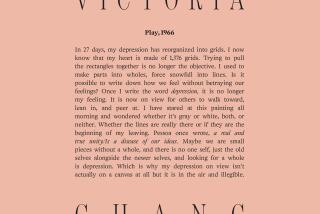Ellen Forney’s ‘Marbles’ details struggles with depression
Marbles
Mania, Depression, Michelangelo, and Me
A Graphic Memoir
Ellen Forney
Gotham: 248 pp., $20 paper
There’s a glorious manic edge to Ellen Forney’s “Marbles,” a graphic memoir about the artist’s battle with depression, which was diagnosed in the late 1990s and remains ongoing, if now essentially controlled.
To some extent, this has to do with the material; Forney is bipolar, which means she suffers manic episodes, as the book recounts. Yet even more, it’s a function of how she puts “Marbles” together, by turns methodical and frenzied, as if channeling her emotions on the page.
In that sense, the book reads less like a comic than a scrapbook, in which traditional strip-style layouts alternate with lists, sketchbook pages, re-created photos — all to reproduce the swirling chaos of her inner life.
Forney, of course, has been producing work like this for many years. Her previous strips have been collected in “I Love Led Zeppelin” and “Monkey Food” (which looks back at her childhood in the 1970s); she also illustrated Sherman Alexie’s National Book Award-winning young adult novel “The Absolutely True Diary of a Part-Time Indian.”
What these efforts share is a quality of engaged irreverence, a sense that Forney is standing on the outside and the inside at once. This, as it turns out, is also a nearly perfect metaphor for depression, which equally enlarges and diminishes her as she careens from the manic to the subdued.
“Memory is mood-specific,” she tells us, by which she means that “[m]y memory of what it was like to be depressed was fuzzy, and heavily-influenced by my mania.... My euphoric mind just couldn’t conjure up that dramatic shift within itself.”
The challenge of “Marbles,” then, is to evoke the two sides of this elusive whole, to remember both the moods and her back-and-forth between them, and to fashion all of it, somehow, into a coherent narrative.
There are significant risks to such a project, and not just because there’s been a glut of memoirs (graphic or otherwise) about depression in recent years. But Forney pulls it off because she’s relatively fearless, both about the difficulties of what she’s undertaken and about revealing herself.
She introduces her first depressive episode with a sketch on lined paper of a wide-eyed figure clinging, by its fingernails, to the edge of a cliff. “I was slipping down and there was nothing I could hold onto,” she writes, a line that highlights the two voices that motivate her work here: the one that’s living in the moment, and the one that’s looking back.
This is an essential tension, not just for “Marbles” but in regard to the memoir in general; it’s a form that relies on a kind of double vision, the story as it was lived and the story as it is being told. Caught up in the experience (as we know because she tells us), Forney was sure she would never come out of it. In that sense, if her book has one essential message, it is that she survived.
“Marbles” is more than a survivor’s story, though; if it weren’t, we’d grow tired of it pretty fast. It is a book about Forney’s struggle to come to terms with herself, which is similar to the struggle everyone must undergo. The best stuff here collapses the distance between reader and artist, either by stripping away distinguishing details or by opening the story to broader concerns.
My favorite page features 14 minimalist drawings — just a few lines, no faces, generic to the point of indistinction — that depict a depressed Forney as she gets out of bed, grabs a blanket, huddles on the couch and falls asleep again. It’s a brilliant bit of visual storytelling, done completely without language, in which we may, perhaps, recognize ourselves.
Forney also takes on the question of identification explicitly, conjecturing about the relationship between mental illness and art. “Isn’t ‘crazy artist’ just a stereotype anyway?” she wonders, after reading Kay Redfield Jamison’s “Touched With Fire: Manic-Depressive Illness and the Artistic Temperament,” which features a list of painters and writers (Gauguin, Van Gogh, Michelangelo, Munch, Artaud, Poe, Plath, Whitman, Pound) who likely suffered from depression. “How do ‘they’ know these people were crazy? … Did their moods affect their work?”
Ultimately, Forney imagines herself as part of a creative lineage, going back to Georgia O’Keeffe and Philip Guston, Mary Shelley and Virginia Woolf. It might seem self-serving if it weren’t so authentic, a way of marking her place in the world.
At the heart of “Marbles,” after all, is a sense of terror: both the terror of depression and the terror of not knowing who you are. For Forney, these artists help to root her, and when, late in the book, she imagines 20 of them — names, faces, birth and death dates all clustered around her head in the form of overlapping thought balloons — it feels like a victory.
“[C]onnections,” she thinks. “[C]ontext, perspective, inspiration, company.” That’s all any of us can ever ask for, regardless of our mental health. And in this exhilarating book, Forney shows us her path to that communion, a communion that begins, as it must for everyone, with the act of coming to some sort of reckoning with herself.
More to Read
Sign up for our Book Club newsletter
Get the latest news, events and more from the Los Angeles Times Book Club, and help us get L.A. reading and talking.
You may occasionally receive promotional content from the Los Angeles Times.







